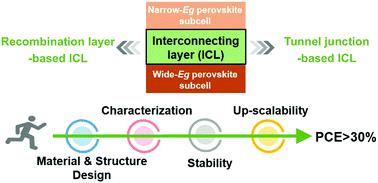当前位置:
X-MOL 学术
›
Energy Environ. Sci.
›
论文详情
Our official English website, www.x-mol.net, welcomes your feedback! (Note: you will need to create a separate account there.)
Efficient interconnecting layers in monolithic all-perovskite tandem solar cells
Energy & Environmental Science ( IF 32.5 ) Pub Date : 2022-05-27 , DOI: 10.1039/d2ee00731b Meng Zhang 1 , Zhiqun Lin 1
Energy & Environmental Science ( IF 32.5 ) Pub Date : 2022-05-27 , DOI: 10.1039/d2ee00731b Meng Zhang 1 , Zhiqun Lin 1
Affiliation

|
Tandem solar cells (TSCs) are widely recognized as an effective device architecture for overcoming the spectral loss in single-junction solar cells and surpassing the Shockley–Queisser (S–Q) limit. Organic–inorganic hybrid perovskites are an emerging class of materials for use in TSCs as light absorbers as they carry a significant set of intriguing attributes, which include tunable direct bandgaps, large absorption coefficients, high ambipolar carrier mobilities, small exciton biding energies, and solution processability. In this context, the ability to engineer all-perovskite TSCs (all-PTSCs) offers new opportunities to render low-cost, low-temperature solution-processing of photovoltaics with markedly enhanced device performance. Notably, an efficient interconnecting layer (ICL) represents a key component for high-efficiency monolithic tandem devices as it concurrently imparts good electrical, optical, and mechanical interconnections between the subcells. In particular, an interdiffusion barrier is required to ensure the chemical stability of the bottom cell against solvents for solution-processed all-PTSCs. In this review, the triple functions of ICLs noted above and the structural requirements for achieving them, as well as the mechanism that underpins efficient recombination in ICLs, are first discussed. Subsequently, recent advances in efficient ICLs (i.e., tunnel-junction-based ICLs and recombination-layer-based ICLs) implemented for monolithic all-PTSCs are critically examined. Finally, the challenges and future opportunities for rationally designing and developing robust ICLs for high-efficiency and stable all-PTSCs are also presented.
中文翻译:

单片全钙钛矿串联太阳能电池中的高效互连层
串联太阳能电池 (TSC) 被广泛认为是一种有效的器件架构,可以克服单结太阳能电池的光谱损失并超过 Shockley-Queisser (S-Q) 限制。有机-无机杂化钙钛矿是一类新兴的材料,可用于 TSC 作为光吸收剂,因为它们具有一组重要的有趣属性,包括可调谐直接带隙、大吸收系数、高双极载流子迁移率、小激子结合能和溶液可加工性。在这种情况下,设计全钙钛矿 TSC(全 PTSC)的能力为以显着增强的器件性能提供低成本、低温溶液处理光伏器件提供了新的机会。尤其,高效互连层 (ICL) 代表了高效单片串联器件的关键组件,因为它同时赋予子电池之间良好的电气、光学和机械互连。特别是,需要相互扩散屏障以确保底部电池对溶液处理的全 PTSC 的溶剂的化学稳定性。在这篇综述中,首先讨论了上述 ICL 的三重功能以及实现这些功能的结构要求,以及支持 ICL 高效重组的机制。随后,高效 ICL 的最新进展(需要相互扩散屏障来确保底部电池对溶液处理的全 PTSC 的溶剂的化学稳定性。在这篇综述中,首先讨论了上述 ICL 的三重功能以及实现这些功能的结构要求,以及支持 ICL 高效重组的机制。随后,高效 ICL 的最新进展(需要相互扩散屏障来确保底部电池对溶液处理的全 PTSC 的溶剂的化学稳定性。在这篇综述中,首先讨论了上述 ICL 的三重功能以及实现这些功能的结构要求,以及支持 ICL 高效重组的机制。随后,高效 ICL 的最新进展(即,对单片全 PTSC 实施的基于隧道结的 ICL 和基于重组层的 ICL)进行了严格检查。最后,还介绍了合理设计和开发稳健的 ICL 以实现高效和稳定的全 PTSC 的挑战和未来机遇。
更新日期:2022-05-27
中文翻译:

单片全钙钛矿串联太阳能电池中的高效互连层
串联太阳能电池 (TSC) 被广泛认为是一种有效的器件架构,可以克服单结太阳能电池的光谱损失并超过 Shockley-Queisser (S-Q) 限制。有机-无机杂化钙钛矿是一类新兴的材料,可用于 TSC 作为光吸收剂,因为它们具有一组重要的有趣属性,包括可调谐直接带隙、大吸收系数、高双极载流子迁移率、小激子结合能和溶液可加工性。在这种情况下,设计全钙钛矿 TSC(全 PTSC)的能力为以显着增强的器件性能提供低成本、低温溶液处理光伏器件提供了新的机会。尤其,高效互连层 (ICL) 代表了高效单片串联器件的关键组件,因为它同时赋予子电池之间良好的电气、光学和机械互连。特别是,需要相互扩散屏障以确保底部电池对溶液处理的全 PTSC 的溶剂的化学稳定性。在这篇综述中,首先讨论了上述 ICL 的三重功能以及实现这些功能的结构要求,以及支持 ICL 高效重组的机制。随后,高效 ICL 的最新进展(需要相互扩散屏障来确保底部电池对溶液处理的全 PTSC 的溶剂的化学稳定性。在这篇综述中,首先讨论了上述 ICL 的三重功能以及实现这些功能的结构要求,以及支持 ICL 高效重组的机制。随后,高效 ICL 的最新进展(需要相互扩散屏障来确保底部电池对溶液处理的全 PTSC 的溶剂的化学稳定性。在这篇综述中,首先讨论了上述 ICL 的三重功能以及实现这些功能的结构要求,以及支持 ICL 高效重组的机制。随后,高效 ICL 的最新进展(即,对单片全 PTSC 实施的基于隧道结的 ICL 和基于重组层的 ICL)进行了严格检查。最后,还介绍了合理设计和开发稳健的 ICL 以实现高效和稳定的全 PTSC 的挑战和未来机遇。


























 京公网安备 11010802027423号
京公网安备 11010802027423号